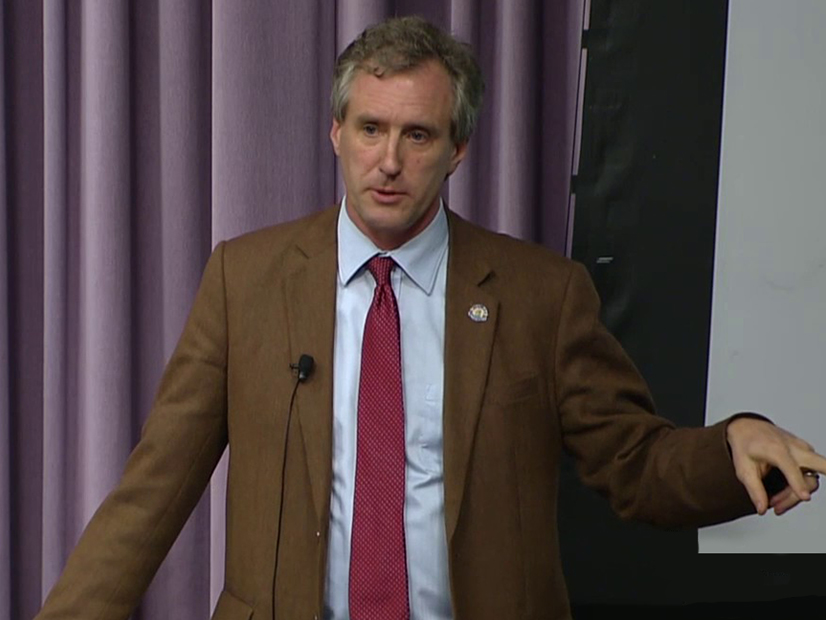As Californians ponder how the state can achieve a 100% clean energy future while maintaining electric reliability, the chair of the California Energy Commission this week offered a two-part solution.
“Offshore wind coupled with storage is how we do that,” CEC Chair David Hochschild said. “Those two things to me go hand-in-hand.”
Hochschild’s comments came Monday during an offshore wind webinar hosted by the California Natural Resources Agency. One listener asked Hochschild if there’s a guarantee that the state will stop using “the dirtiest forms of energy” once offshore wind is deployed.
Hochschild noted that state law requires all electric retail sales to come from renewable and zero-carbon resources by 2045. At the same time, he said, “the paramount issue is reliability.”
The CEC chair spoke enthusiastically about offshore wind, which he said could power a home for a day with a single turbine rotation.
“In my judgment, after rooftop solar, offshore wind is the lowest-impact form of electric generation in the world,” Hochschild said. And offshore wind is “highly aligned” with the late afternoon and early evening hours when power is most needed, he said.
The webinar was moderated by Natural Resources Secretary Wade Crowfoot as part of his Secretary Speaker Series. Crowfoot said more than 500 people tuned in to the session.
Optimizing Locations
For California offshore wind, floating turbines would be 20 to 30 miles off the coast — a location with potential environmental advantages.
“We are very pleased … that this floating technology is able to push projects 20-plus miles from shore,” said webinar speaker Kristen Hislop with the Santa Barbara-based Environmental Defense Center. “Many environmental groups are very concerned about projects closer to shore.”
Hislop said the nonprofit is optimistic about offshore wind’s potential to help California fight climate change, reduce air pollution and improve energy reliability. At the same time, she said, choosing offshore wind sites should consider species and habitat data and not just wind speed and technical considerations.
“We don’t want to see projects inadvertently impact migrating whales, birds and bats, sea turtles, sharks, fishes and other animals that rely on the California coast,” Hislop said.
Another webinar speaker was state Sen. John Laird (D), whose Central Coast district includes the site of the Diablo Canyon nuclear power plant.
Laird said he took part in negotiations over postponing the retirement of Diablo Canyon’s two reactors, which had been planned for 2024 and 2025. The state is now eyeing a 2030 closure date for the plant.
“I helped fashion that deal in a way that if there was going to be an extension, it would be just extended to the time that offshore wind was coming on, so that we could transition the transmission in that area to use [for] the offshore wind,” Laird said.
First Auction Completed
Last month, the U.S. Bureau of Ocean Energy Management held an offshore wind auction for five leases off the Northern and Central California coasts. The auction, the first for the West Coast, brought in $757 million from the five winning bidders combined. (See First West Coast Offshore Wind Auction Fetches $757M.)
The five lease areas — three off the Central Coast in the Morro Bay Wind Energy Area and two off the Northern California coast in the Humboldt Wind Energy Area — have a total capacity of up to 4.6 GW.
That’s far short of the state’s goal of 25 GW of offshore wind capacity by 2045, and some are already thinking about the next auction.
“We need to move quickly to develop siting plans for the next set of call areas,” said Adam Stern, executive director of Offshore Wind California, an industry coalition.
Stern pointed to planning areas off the coast of Mendocino and Del Norte counties, saying there’s potential for another auction within two years. He said stakeholder involvement is crucial.
“It’s critical that all of the constituencies that are represented on this call are part of this discussion,” Stern said.
That theme was emphasized throughout the webinar.
“How do we get this done as quickly as climate change demands?” Crowfoot said in recapping the offshore wind conversation. “But in a way that’s actually inclusive and thoughtful and careful to avoid and mitigate impacts.”
